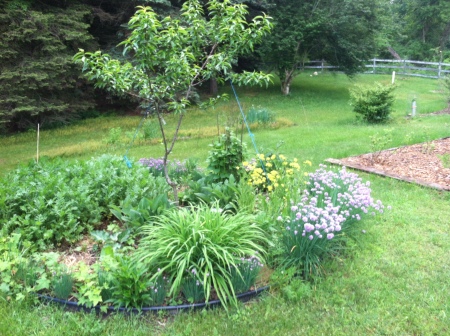POMONA
The Member-Written, Quarterly Journal of North American Fruit Explorers (NAFEX)
Vol. XLVI, No. 3, Summer 2013
Fruit Tree Polycultures
Trevor Newman
tnewman92@gmail.com
(P) 248-535-9419
(F) 248-625-7676
The Fruit Nut | http://www.thefruitnut.com
Unlike monocultures, polycultures contain diverse mixtures of species growing together in symbiosis. Creating polycultures around fruit trees can reduce the need for offsite inputs, increase biodiversity in the orchard, and provide various secondary yields such as medicinal herbs, perennial vegetables, and much more. Establishing polycultures around fruit trees is all about analyzing the needs of the tree and matching those needs to the functions of various support species or ‘companion plants.’ The aim is to provide the basic needs of the tree (fertility, pest management, weed control, etc.) by using biological
resources. Instead of ‘planting a fruit tree,’ we can think of this integrated approach as ‘planting an ecosystem’.
Dynamic accumulators are plants whose deep taproots mine hard-to-reach minerals from the soil and deposit them in their aerial parts. These plants can be grown around the base of fruit trees and managed on a ‘chop-n-drop’ basis whereby their aerial parts are occasionally cut and spread as mulch directly beneath the trees. Comfrey (Symphytum officinale) is a great example of a dynamic accumulator that is high in calcium, phosphorus, and manganese. I put at least one comfrey plant at the base or around the
drip line of each tree and generally cut them back for mulch 3-4 times throughout the growing season.
Nitrogen-fixing plants are commonly used in organic agriculture as cover crops and green manure. The same principles can be applied to the orchard by using nitrogen fixing trees, shrubs, and herbs to act as nurse crops for young fruit trees. A great multi-purpose nitrogen fixer is goumi (Eleagnus multiflora), which produces an early-season berry and provides an abundance of nectary flowers which honeybees
love. When goumi and other nitrogen fixers are cut down, their roots respond by releasing a plume of nitrogen into the surrounding soil. Fruit trees and other crop plants can tap into this fertility source.
Groundcover plants are excellent weed suppressors and should be integrated throughout the orchard understory to act as living mulch while excluding any potential for weeds to grow. Applemint (Mentha suaveolens) and white clover (Trifolium repens) are two groundcovers that can be effectively integrated with orchard grass to create a dense mat. Creeping comfrey is an excellent groundcover that spreads
indefinitely, can tolerate shade, and also serves as a dynamic accumulator.
Another class of functional plants are known as insectaries. These are plants that provide fodder for beneficial and predatory insects. By attracting these ‘good guys’ to the orchard we can increase pollination and limit pest outbreaks by encouraging a balance among predator and prey populations. Plants in the Apiaceae family (carrot, lovage, etc.) and plants in the Asteraceae family (yarrow, coneflower, etc.) are especially good at attracting predatory insects like parasitic wasps, lace wings, and lady beetles. Having insectary plants flowering at different times throughout the year ensures that beneficial insects will have a plentiful supply of food and reason to stick around.
The core of good polyculture design lies in a basic understanding of ecology and plant functions. Polycultures mimic functional interconnections found in natural ecosystems while producing an abundance of yields and reducing off site inputs. Visit www.apiosinstitute.org to see numerous case studies and find out more about designing fruit tree polycultures.

